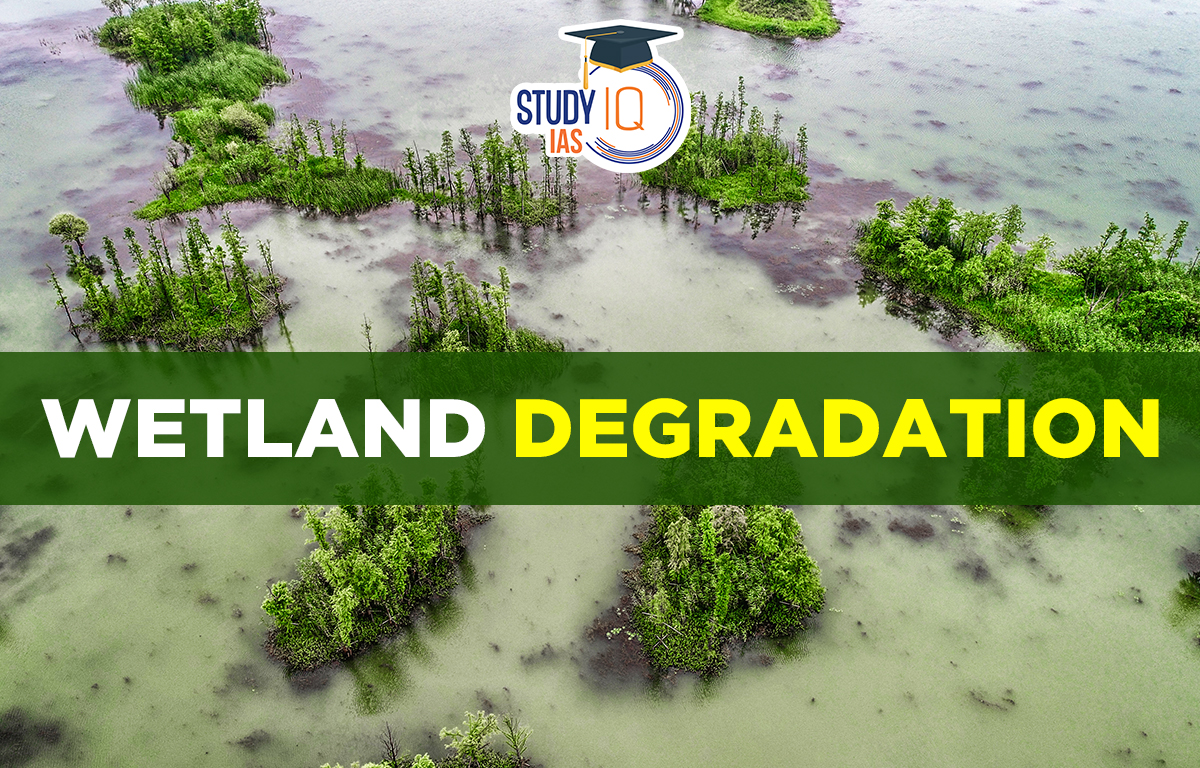Table of Contents
Key Highlights from the Wetland Degradation Report
- Wetland degradation: According to the estimates, India has lost nearly two of five wetlands in the last 30 years, while 40% of them can’t support aquatic animals.
- Major causes of degradation:
- Unplanned urbanization: Vadodara lost 30% of its wetlands between 2005 and 2018, while Hyderabad has lost 55% of its semi-aquatic bodies due to inefficient waste management and unchecked urban development.
- Erosion: The largest wetland in India, the Sunderbans has lost around 25% of its mangroves due to erosion over the past three decades. One of the main culprits for this is reduction in sediments due to upstream dams.
- Waste disposal: Due to lack of knowledge on wetlands and their ecosystem, most wetlands end up being abused as sites of waste disposal, resulting in their widespread loss.
- Reclamation: Reclamation activities have caused massive declines in coastal wetland areas. With the increasing human activities, the coastal wetland ecosystems were destroyed or replaced by a drained and impervious surface.
- Impacts of Degradation:
- Flood vulnerability: Degeneration of urban wetlands due to unplanned development compromises the landscape’s resilience to floods. For example, 2015 Chennai floods.
- Current scenario of protection: India presently has around 2.2 lakh big wetlands covering over 2.2 hectares and 5.5 lakh smaller ones.
- Of these, nearly 60,000 big wetlands are situated inside protected forest areas which could be deemed as safe.
- Of the remaining, conservation work has been carried out on 150 to 200 water bodies so far.
- A total of 75 Indian wetlands with a surface area of over a million hectares are designated as wetlands of international importance under the Ramsar Convention.
About Wetlands International
- It is an independent, not-for-profit, global organization that works to sustain and restore wetlands and their resources for people and biodiversity.
- It was founded in 1937 and was formerly known as International Waterfowl & Wetlands Research Bureau (IWRB).
- Headquarters: Ede, Netherlands
- It coordinates the International Waterbird census of which the Asian Waterbird census is an integral part.
- Also, it is one of the International Partner Organizations of the Ramsar Convention.
What are Wetlands?
- Wetlands are defined as: “lands transitional between terrestrial and aquatic eco-systems where the water table is usually at or near the surface or the land is covered by shallow water”.
- Types of Wetlands:
- Marshes: These are wetlands that are permanently flooded or flooded during high water periods at the edges of rivers, streams, lakes, or ponds.
- Sedge meadows (or wet meadows): These are wetlands with permanently or near-permanently saturated soils. They may form a transitional zone between marshes and other wetlands with less-saturated soils, or around groundwater discharge zones.
- Fens and seeps: These are wetlands that are fed by groundwater that “seeps” out to the soil’s surface.
- Bogs: These are basin wetlands for which precipitation is the only source of water; they are typically not fed by surfacing groundwater or streams.
- Swamps: These are wetlands dominated by woody vegetation that typically have standing water during at least certain times of the year.
- Ecosystem services provided by wetlands:
| Cultural | Ecotourism and recreation: Wetlands can be used as parks to observe and enjoy unique organisms and habitats. |
| Provisioning | Water source: Wetlands can remove impurities from water, providing a drinking water source.
Raw materials: Wetland soils are fertile, and could be used for farming. |
| Regulating | Water regulation: Wetlands store water, helping to prevent floods and to provide water during times of drought.
Climate regulation: Wetlands are source and sink for greenhouse gases; influences local and regional temperature; precipitation, and other climatic processes. Natural hazard regulation: Flood control and storm protection. |
| Supporting | Nutrient cycling: Microorganisms in wetlands can remove excess nutrients from the water.
Photosynthesis: Plants within wetlands can acts as oxygen source (and carbon sink). |
- Efforts Towards Wetland Conservation:
| At Global Level | The Ramsar convention: It envisages the conservation and wise use of all wetlands through local and national actions and international cooperation. It came into force in 1975.
Currently, India has 75 Ramsar sites which are the highest in South-Asia. The Montreux Record: The Montreux Record is a database of wetland sites on the Ramsar Wetlands of International Importance List that have undergone, are undergoing, or are projected to experience changes in ecological status as a result of technological advancements, pollution, or other human interference. |
| At National Level | Statutory Protection: In India, the wetlands are regulated under the Wetlands (Conservation and Management) Rules, 2017.
Action Plan of MoEFCC: The Ministry of Environment, Forest and Climate Change (MoEFCC) supports the implementation of management action plans for over 250 wetlands under schemes such as National Plan for Conservation of Aquatic Ecosystems, Mangroves and Coral Reefs, and Integrated Development of Wildlife Habitats. |



 UPPSC Previous Year Question Papers, Dow...
UPPSC Previous Year Question Papers, Dow...
 Most Commonly Used Cancer Drugs and Thei...
Most Commonly Used Cancer Drugs and Thei...
 Tansen Biography, Musical Legacy and Mas...
Tansen Biography, Musical Legacy and Mas...





















